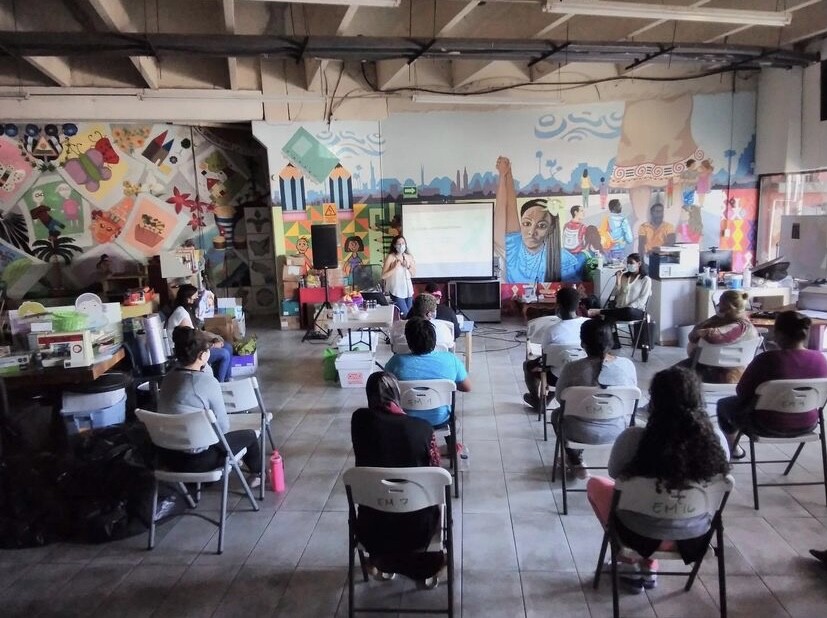How to Support Migrant Families, Wherever You Are

Espacio Migrante is a Tijuana-based binational community group founded in 2012 to provide educational tools for Baja California's migrant and refugee community. It eventually expanded its mission to work on both sides of the U.S.-Mexico border and opened their very own shelter for migrant families, as well as the Espacio Migrante Cultural and Community Center in Tijuana's Zona Urbana Río.
Today, Espacio Migrante works directly with diverse migrant communities from Latin America, the Caribbean and Africa, as well as migrant women, men, youth and children. Espacio Migrante director and founder Paulina Olvera Cáñez shares how the organization has set out to change the narrative about immigrants through multidisciplinary programs and the ways we can support them.
"We started by doing cultural events," she says. "We don't want to pretend like everything is happy — we feel that all these policies that are making people wait in Mexico are also meant to discourage people from trying to seek asylum. Both governments are hoping people are going to get tired of waiting and go back to their country. It's a very hard situation but we also see that migrant communities and border communities are resilient and strong and that's what we want to highlight. We have found that art and culture is not only a way to heal but also a way to resist and to show a different narrative about what is happening."
Become a Volunteer

Many organizations need additional manpower just to keep their programs going. Their needs can vary depending on the work they're doing. Espacio Migrante, for example, has a number of cultural programs up and running, for which they're constantly searching for additional help on such as:
- A cooking project, where they partner with a local Haitian restaurant to cook meals that are culturally appropriate and considerate of the community's religious dietary restrictions. Espacio Migrante also invited people from different immigrant communities in Tijuana to share a recipe and talk about their culture. The nonprofit is currently looking to work with graphic designers and copyeditors who can help them create a recipe book.
- A community telenovela, where they asked migrant children to help craft stories. Film students then turned these tales into telenovelas. "The idea is that this telenovela can be used to share real stories about what's happening with migrant families trying to access education," said Olvera Cáñez. They are now sourcing funding for post production and editing, as well as searching for editors and those who know about filmmaking to work on the project.
- An artist festival called Miradas Fronterizas, dedicated to the theme of migration. Held every year in November, the non-profit works with local artists and students on both sides of the border — students from Mexico's Universidad de Tijuana, La Universidad Iberoamericana, Autonomous University of Baja California and, in California, University of San Diego and University of California San Diego.
Help Translate
Language access has been one of the biggest challenges in spreading public information because the Haitian community speaks Haitian Creole or French. After Haitians arrived, Tijuana also received a lot of African migrants from different countries. Most organizations don't have any staff that speak these languages, but receives information regarding policies, laws, supporting and informational documents from the organizations that they work with in the U.S. (like San Diego Immigrant Rights Consortium, ACLU, Jewish Family Service and Al Otro Lado). One way to help is by volunteering to translate vital information, provide interpretation or interview people. Translators don't necessarily have to be in Mexico as this service can be done remotely.
Share In-Kind Donations

In-kind donations have been difficult for nonprofits to maneuver because the border was closed during the pandemic. Often, only those who could cross the border could bring donations back and forth. In response, some nonprofits like Espacio Migrante x set up a drop-off location that can be accessed without crossing the border. Donors can also contact these organizations directly to find out if there are other possible drop-off locations that are available. In-kind donations can include the following: food, clothing, office and educational materials, such as notebooks, pens, books, art supplies and teaching materials.
Explore Monetary Donations
Many nonprofits depend on community support and monetary donations to help continue critical programs. Espacio Migrante, for example, started providing prepaid cards for migrants, so they can purchase food and other necessities. Unfortunately, these programs are only active for as long as funds are available.
Support, Amplify and Share Immigrant Organization Voices

Awareness is a critical component of many of these immigrant programs, but nonprofits are often challenged because of their geographic location. "It's harder for us to reach the U.S. audience because we're based in Tijuana," said Olvera Cáñez, "So just by sharing our projects, our posts, our website and contact information and what’s happening at the border on social media is a great way to help."



